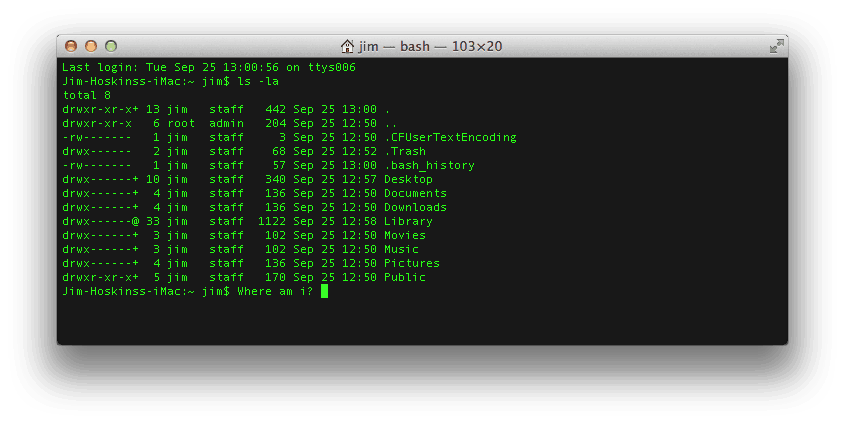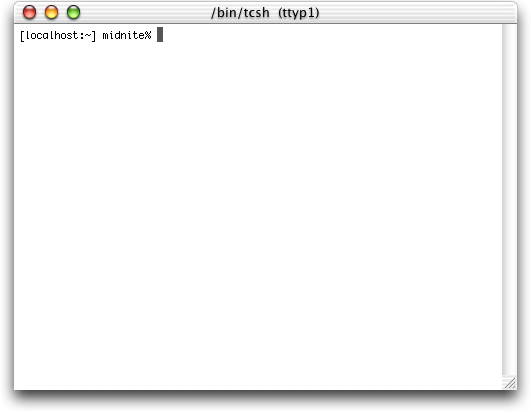
Download Visual Studio Code for macOS. Double-click on the downloaded archive to expand the contents. Drag Visual Studio Code.app to the Applications folder, making it available in the Launchpad. Add VS Code to your Dock by right-clicking on the icon to bring up the context menu and choosing Options, Keep in Dock. Launching from the command line. A command prompt is a non-graphical interface that allows you to interact with your operating system. At the command prompt, you enter commands by typing their names followed by options and arguments.
| Click here to return to the 'Installing packages from the command line' hint |
- READY ($) - A dollar sign signifies that the prompt is ready to accept your command. You do not type the $, it's just there. On a Windows computer, this is represented by a symbol. A terminal or command prompt is a program (command line interface) that runs a shell, which interprets the commands.
- If your Mac is using a firmware password, you're asked to enter the password. Option-Command-P-R: Reset NVRAM or PRAM. If your Mac is using a firmware password, it ignores this key combination or starts up from macOS Recovery.
- You can open a PowerShell window, Command Prompt window, or a Terminal window to a specific folder from within the file manager. Today, we’ll show you how to do this in Windows, Mac, and Ubuntu.
- Aug 07, 2019 How to Run Exe from Cmd on PC or Mac. This wikiHow teaches you how to use command lines in Windows Command Prompt in order to start and run an executable (exe) file on your computer. Open your computer's Start menu. Click the Start button.
is that some packages (notably Fink) don't work using this installer application. Kind of frustrating when you need a command-line app on a remote computer and you can't install Fink in order to install the app! :-)
---
www.AcornWebDesigns.com
Quality websites for inexpensive prices (Is that an oxymoron?)
I also discovered this installer command the day that I read the recent article here about installing a no-ip linux client as a startup item. The .pkg that was pointed to by that article did not work via the command line. I had to do it from home. Even then it still didn't seem to be workgin right, though, so I removed it and installed the fink version which seems to be working, once I understood how to set that version up. A fully working command-line installer is much needed, but if it works on some things now that's still pretty good....
---
--- I hate Microsoft and I vote

cd /
sudo /usr/sbin/installer -pkg /path/to/pkg.pkg -target / ---
4am Media, Inc. Mac OS X Training and Consulting
sudo reboot is a harsh command, I believe you'd use all unsaved documents, I wouldn't recommend doing it this way.
Something like:
sudo osascript -e 'tell application 'Finder' to restart'
Would be much better. It would get canceled if there is unsaved data.
arr, but if your using the cli to install packages most likely the box is on a remote site, so u cant press 'save' or 'don't save' and the restart would time out
there has to be away of avoiding this because it would be nice to be able to restart and / or log out a user via the cli
jameso
---
'The time has come,' the walrus said. 'To talk of many things...'
Then use localhost & port 5900 in your vnc client. You can have the remote machine always running the vnc server, or run it from the ssh shell.
Of course, if you go this route, isntalling via the CLI is pointless since you can just do it via the GUI.
The applescript is all very nice, but if no one is logged into the remote machine is does not work, the response is '29:36: execution error: Application isn't running (-600)' (tested with OS X 10.3.5)
This is great. Now if only I could create packages from the command line rather than using PackageMaker interactively.
You can create packages from the command line. i've done it in 10.4, but haven't tried in 10.5.
in tiger, PackageMaker will load in /Developer/Applications/Utilities/PackageMaker.app
but really all .app's are just folders, so you can call the CLI by /Developer/Applications/Uitilities/PackageMaker.app/Contents/MacOS/PackageMaker
you'll have to feed it a number of flags like -build and -p... i think there's a man page for it somewhere.
If you look in /usr/sbin/ a couple of utils already stand out because of their name:
AppleFileServer
AppleSystemProfiler
DirectoryService
PasswordService
installer
softwareupdate
am-eject
nvram
system_profiler
appletalk
asr
bootparamd
disktool
screencapture
diskutil
You can find out what they do by looking at their man pages or running them (not as root obviously)
Some of these don't have man pages. Notably (for me):
opendiff - run the cocoa diff utility on two files
scselect - select network location
disktool - I'm sure this does something handy
To use any of these key combinations, press and hold the keys immediately after pressing the power button to turn on your Mac, or immediately after your Mac begins to restart. Keep holding until the described behavior occurs.
If your Mac is using a firmware password, all of these key combinations are disabled, except as noted below.
Command (⌘)-R: Start up from the built-in macOS Recovery system. Or use Option-Command-R or Shift-Option-Command-R to start up from macOS Recovery over the Internet. macOS Recovery installs different versions of macOS, depending on the key combination you use while starting up. If your Mac is using a firmware password, you're asked to enter the password.
Cmd Prompt For Mac
Option (⌥): Start up to Startup Manager, which allows you to choose other startup disks or volumes, if available. If your Mac is using a firmware password, you're asked to enter the password.
Option-Command-P-R:Reset NVRAM or PRAM. If your Mac is using a firmware password, it ignores this key combination or starts up from macOS Recovery.
Shift (⇧): Start up in safe mode.
Command Prompt For Macbook Air
D: Start up from the built-in Apple Hardware Test or Apple Diagnostics utility, depending on your Mac model. Or use Option-Dto start up from this utility over the Internet.
N: Start up from a NetBoot server, if your Mac supports network startup volumes. To use the default boot image on the server, hold down Option-N instead.
Command-S: Start up in single-user mode. This key combination requires macOS High Sierra or earlier.

T: Start up in target disk mode.
Command-V: Start up in verbose mode.
Eject (⏏) or F12 or mouse button or trackpad button: Eject removable media, such as an optical disc.
Learn more
- Learn what to do if your Mac doesn't turn on.
- Learn about Mac keyboard shortcuts that you can use after your Mac has started up.